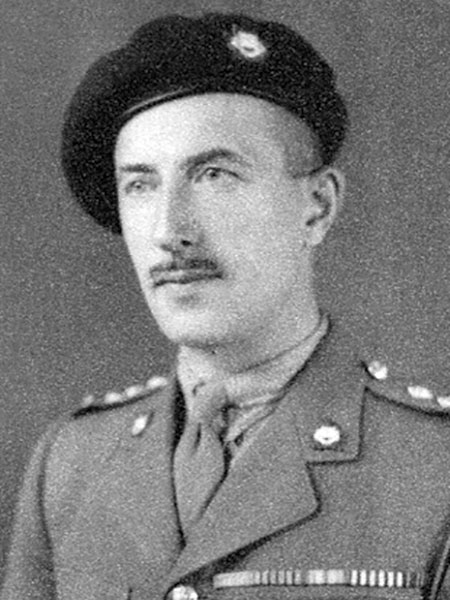 |
Hippolyte Johanny Wickey
|
Educator, SOE war hero.
Born Hippolyte Johanny Wicky at Lyon, France on 9 June 1899 to Swiss parents, he attended school in Switzerland and grew up fluent in French and German. During the First World War, he saw military service in 1917 as a machine gunner with the 412th Regiment of a Moroccan Division which was attached to the French Foreign Legion. He made Sergeant Major at the age of 18 and won three field decoations during the conflict: the French Croix de Guerre (1918), Belgian Croix de Guerre, and French Medaille militaire [Military Medal]. He remained with the Legion following the war and was stationed in North Africa. In 1922, he travelled to New Zealand and he married Anne Marie ? (1899-1989) in September 1926. They had a son, John “Jack” Wickey.
The family settled in Manitoba in 1928. Thereafter, he went by the name John and changed the spelling of his name from Wicky to Wickey. They lived at Winnipeg, in the Maple Leaf Apartments, and he began working as a school teacher, including as Principal of Winnipeg Beach School (1934-1938).
He joined the Fort Garry Horse in 1931 and was promoted to the rank of Lieutenant in 1937. On 1 September 1939, he was promoted to the rank of Captain upon enlistment for wartime service. From 1939 to 1943, he performed training duties in Canada and England. He was posted to bases in England and at Camp Borden in Ontario to provide tank gunnery instruction to Canadian servicemen over the next four years. In 1944, he answered a call for French and German-speaking personnel and reported to London, England for what was a clandestine recruitment drive of Special Operations Executive (SOE). After passing multiple screenings, he trained as an SOE agent for five weeks and undertook three practise parachute jumps at bases in Oldham and Ringway. His mission, in the leadup to D-Day and Operation Overlord, would be to infiltrate into France prior to the Allied invasion of Normandy, gather intelligence on German troop concentrations and movements, scout for V-1 launch sites, and spread misinformation as to where the assault was likely to occur.
He adopted the identity of Joseph Garnier, an Alsacian Frenchman, and was successfully dropped into occupied France near Le Mans on 23 May 1944. Between then and 9 June 1944, he operated behind enemy lines, eventually crossing back over into the Canadian area of the Normandy beachhead on his birthday. Following a return to London for debrief and leave, he rejoined his unit. In 1945, he was named Military Governor of 718 Military Government District at Wuppertal, Germany within the British Occupation Zone. A Major by this time, he returned to the FGH post-War and worked as a training officer at Winnipeg. For his contributions to the liberation of the Netherlands, he was awarded the Order of Orange-Nassau with Swords (Officer) by the Dutch government (1947).
In 1947, he joined the Canadian civil service as a corrections officer at the Stony Mountain Penitentiary where he was later Deputy Warden (1963). In 1952, he became the first Officer Commanding the #5 Intelligence Training Company based at Winnipeg. He transferred to the Canadian Army (Supplementary Reserve) Royal Canadian Armoured Corps in 1955 and would retire a Lieutenant Colonel. He was a member of the Royal Canadian Legion, Lethbridge Military Institute (Vice-Patron), Fort Garry Horse Association, Canadian Intelligence & Security Association, 1914-1918 Veterans Association, and the French Foreign Legion Association. He retired to Lethbridge, Alberta in 1969.
He died at the Lethbridge Regional Hospital on 15 February 1994 and his cremains were buried locally in the Mountain View Cemetery.
“7 Winnipeg soldiers promoted overseas,” Winnipeg Free Press, 16 January 1945, page 16.
“[Photo caption; Dutch award],” Winnipeg Tribune, 22 March 1947, page 31.
“Manitoban was spy in occupied France,” Winnipeg Free Press, 26 October 1963, pages 21 and 22.
“It was cold, lonely behind enemy lines,” Lethbridge Herald, 16 July 1983, page A1.
“History marked Wickey for duty,” Lethbridge Herald, 16 July 1983, page A3.
Obituary [Anne Marie Wickey], Lethbridge Herald, 7 October 1989, page 2.
Obituary, Lethbridge Herald, 17 February 1994, page D6.
Major H. John Wickey, 38 Service Battalion Combat Service Support Museum.
“Presentation on Major John Wickey,” by Martin Zeilig, 17 Wing VoxAir, 23 November 2022.
Awards and Decorations [Officer, Order of Orange-Nassau With Swords], Fort Garry Horse.
Mountain View Cemetery [Lethbridge, Alberta] burial transcriptions, FindAGrave.
This page was prepared by Nathan Kramer and Robert Nash.
Page revised: 27 May 2024
Memorable Manitobans
This is a collection of noteworthy Manitobans from the past, compiled by the Manitoba Historical Society. We acknowledge that the collection contains both reputable and disreputable people. All are worth remembering as a lesson to future generations.
Search the collection by word or phrase, name, place, occupation or other text:
Custom SearchBrowse surnames beginning with:
A | B | C | D | E | F | G | H | I | J | K | L | M | N | O | P | Q | R | S | T | U | V | W | Y | ZBrowse deaths occurring in:
1975 | 1976 | 1977 | 1978 | 1979 | 1980 | 1981 | 1982 | 1983 | 1984 | 1985 | 1986 | 1987 | 1988 | 1989 | 1990 | 1991 | 1992 | 1993 | 1994 | 1995 | 1996 | 1997 | 1998 | 1999 | 2000 | 2001 | 2002 | 2003 | 2004 | 2005 | 2006 | 2007 | 2008 | 2009 | 2010 | 2011 | 2012 | 2013 | 2014 | 2015 | 2016 | 2017 | 2018 | 2019 | 2020 | 2021 | 2022 | 2023 | 2024 | 2025
Send corrections and additions to this page
to the Memorable Manitobans Administrator at biographies@mhs.mb.caCriteria for Memorable Manitobans | Suggest a Memorable Manitoban | Firsts | Acknowledgements
Help us keep
history alive!